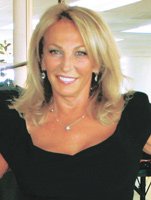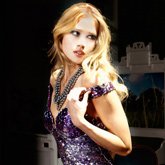Dina Bar-El Poised for Growth
Dina Bar-El, the Los Angeles–based designer known for her eponymous line of gowns and cocktail dresses, is ready for the domestic economy to rebound in a big way.
“The last few years have been extremely challenging for [retailers in the United States],” she said during a tour of her 10,000-square-foot headquarters at the Cooper Design Space in downtown Los Angeles.
Last year, to accommodate retailers’ price sensitivity, Bar-El adjusted her price points by sourcing less-expensive fabrics in safe black and gray hues and paring down the flash in her cocktail dresses to make them more day-to-night friendly. “Women needed to feel justified in buying a dress. They needed to see that it could serve a variety of purposes,” she said.
For 2011, Bar-El is bringing back the shiny satins, fun prints and saturated jewel tones that have landed her gowns in movies, red carpets and dance floors since her launch 26 years ago. The designer is even stepping out of her comfort zone and plans to offer fuller gowns made of organza. “I sense a change in the market. I think there is a renewed sense of optimism. Women are going to want color again. They’re going to want to spend money,” she said.
Bar-El—who produces her dresses in Los Angeles and cuts, sews samples, sells and distributes her dresses from her headquarters—said she is uniquely positioned to take advantage of this shift, thanks to the strength of her international business.
“My international business has been my secret weapon during the recession,” she said. Now, Bar-El sells her dresses in Great Britain, Europe and the Middle East and continues to look for more international distribution options. “They love me!” she laughs. “I’m a bigger deal overseas than I ever have been here.” Approximately 75 percent of her business is through international department stores and specialty retailers, keeping her business steady even as her domestic distribution took a hit.
Bar-El credits her brand’s “Made in the U.S.A.” tag with helping it gain traction in the overseas market. “[International buyers] don’t come to the United States looking for dresses made in China,” she said. The label’s bright hues, feminine silhouettes and craftsmanship are other key selling points, she added.
Bar-El’s international business enabled the Dina Bar-El label to largely continue with business as usual while other brands were forced to whittle away at their offerings or cut staff. “We didn’t lay anyone off. I am very proud of that—and it means we’re fully [operational],” she said of her staff, which numbers 18 people.
And when domestic stores begin to ramp up their buys, Bar-El said, she’ll be ready to respond quickly.—Erin Barajas


























